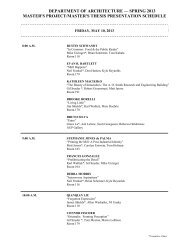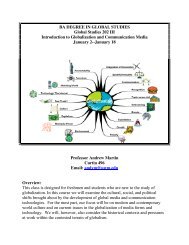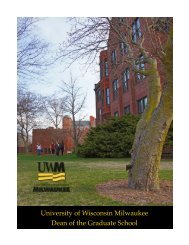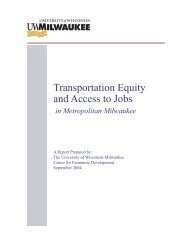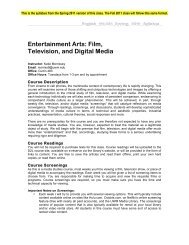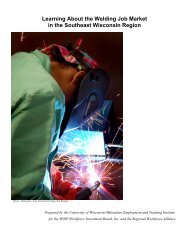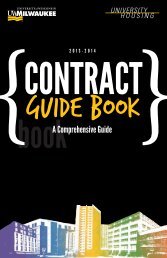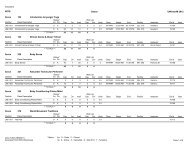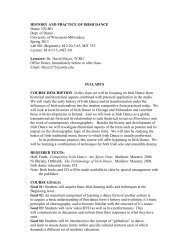FALL 2008 - UW-Milwaukee
FALL 2008 - UW-Milwaukee
FALL 2008 - UW-Milwaukee
Create successful ePaper yourself
Turn your PDF publications into a flip-book with our unique Google optimized e-Paper software.
F A C U L T Y / S T A F FP R O F I L ESwarnjit AroraBy Marla HyderProfessor Swarnjit Arora can stillsee the bodies. Bloodied andmaimed, they line the path ofescape from his home in western Punjabacross the newly carved boundarybetween Pakistan and India. It is 1947and the British Indian Empire has beenabruptly partitioned into separatecountries, triggering an explosion ofviolence between Muslims, Hindus,and Sikhs. Two of Arora’s uncles havebeen burned alive.One by one, seven-year-old Arora,his five siblings, and his parents andgrandparents cross the monsoonfloodedRavi River on the back of acamel, their only means of transportation.“The trains were massacres,”Arora remembers. “Sikhs and Hinduswere killing everyone going in onedirection, Muslims were killing everyonegoing in the other direction.”Once in India, Arora’s familytraveled from one refugee camp toanother, finally landing in Kingsway, alarge camp in Delhi. The drastic changewas disorienting. “One day, you have abeautiful home, friends, and business,and then in 24 hours you get pluckedand moved and have nothing,” Arorasays. With a little help from the government,they eventually moved into aone-bedroom, tin-roofed shelter inNew Delhi. Although there were noschool buildings, Arora began to learnHindi; his former studies in Urduwere of no use in this new country.At nights, in order not to disturb thenine others sleeping in the sameroom, he did his homework outsideunder a street lamp.An early propensity for mathematicsset the course for Arora’s career.While an honors student in mathematicsat the University of Delhi, Arora bene -fitted from a new program insti tuted bythe chancellor, who brought “the bestof the best” from Harvard, Oxford,and Cambridge to teach economicswith an emphasis on econometrics, orthe use of math and statistics ineconomics. Thanks to the chancellor’s“experiment,” Arora studied underfuture Nobel Prize winner AmartyaSen and other top economists. Upongraduating with their master’s degrees,most of Arora’s classmates headed tothe United States or Europe. “All ofmy friends were leaving, so I thoughtI’d better go, too,” he remembers.Arora arrived in Buffalo, New York,on August 27, 1967 with $3.54 in hispocket to begin a doctoral program atthe State University of New York atBuffalo. Five years later, with a freshlyminteddoctorate from Buffalo andpost-doctorate from the NationalBureau of Economic Research, Aroramade his way to <strong>UW</strong>M.“The people have been the bestof the best here,” says the belovedprofessor, extolling the faculty, students,and quality of life that have kept himhere for the past 36 years. Though hetraveled back to India to marry thewoman his father chose for him, andthough he has held visiting professorshipsin England and Germany andtraveled frequently around the world,he always comes back to <strong>Milwaukee</strong>.Arora has passed his love of travel andsense of global citizenship to his son,who currently lives and works inSingapore, and his daughter, whogathers data in Africa and India anduses computer models to calculatemedicinal demand for the ClintonFoundation’s HIV/AIDS relief work.Arora’s work at <strong>UW</strong>M has beenrecognized with numerous honors, buthis service extends far beyond <strong>UW</strong>Minto the wider community, partlythrough the Institute for Survey andPolicy Research, which he has directedsince 1982. Since its inception in 1968,the Institute has evolved into a majorresearch resource for the entire stateof Wisconsin, in addition to providingresearch support to faculty and the<strong>UW</strong>M community. Its surveys andpolicy papers are regularly used bylegislators to influence public policy.“One of our whole objectives isthat we cannot live in ivory towers,”says Arora. “It’s important to bridgethe gap between the university andthe community.” The Institute iscurrently focusing on Wisconsin’seconomic health and how to stop the“brain drain” by cultivating jobs thatwill bring the younger generations back.As much as he believes in hishighly-acclaimed research and in thecomputer programs he develops,those aren’t what ultimately motivatesArora. “Interaction with students iswhat keeps me going after 44 years ofservice,” he says. He has mentoredmany students, especially students fromIndia. Arora passionately believes thatthe university and community mustsupport students coming from othercountries and help ease their cultureshock, but he expects a lot from these— and all — students in return:“Work your tails off. I came herewith no money. I didn’t know anyone.Education saved me and it’s the onlything that will take you anywhere. Theonly way you’re going to succeed iswork, work, work.”He has certainly taken his ownadvice, and it has carried him throughtragedy into a life of service and asuccessful career. To use his favoritephrase, Swarnjit Arora is “the best ofthe best.”Fall <strong>2008</strong>/Myriad 19



